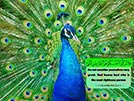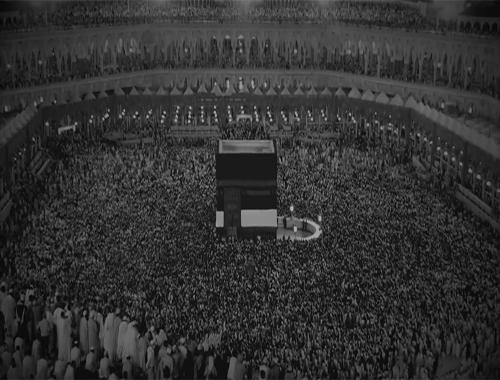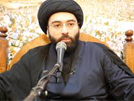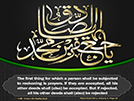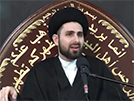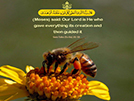Articles
The Relationship of the Qur'an to Modern Science
- Details
- Hits: 3114
The Relationship of the Qur’an to Modern Science
The Qur’an deserves to be evaluated from different points of view. One topic for examination is the artistic and verbal beauty of the Qur’an and its style which is neither poetry nor prose. It does not have the characteristics of poetry, which may be thought as giving free flight to the imagination and indulging in poetic exaggeration, and equally it does not exemplify conventional prose, for it is imbued with a distinctive rhythm and melody that are the means for it to exert a powerful and unique spiritual attraction on all who make its acquaintance.
Then the intellectual and scientific content of the Qur’an also calls for examination. It is true that it is not the aim of the Noble Qur’an to uncover and expound scientific phenomena, to set forth all the natural motions and events that occur within the system of being in accordance with a specific set of laws, or to explain the properties and mode of operation of nature.
We should not expect the Qur’an to discuss, in an organized manner, the various branches of science and to analyze the topics connected with each of those branches, or to solve the various problems that are encountered in different fields of research. The ability to experiment and to conduct scientific research has been made inherent in the human being's nature, and he can obtain the knowledge and the arts he needs in his life by means of thought and reflection. He makes valuable advances through his unceasing efforts to gain control over the forces of nature. Concerns such as these are alien to a book of moral edification.
The aim pursued by the Qur’an is the training of the human being as a being conscious of his duties; it reinforces and accelerates his spiritual ascension, together with all of his qualities, toward a state of true loftiness and the dignity of which the human being is worthy. The emergence of such a being requires a comprehensive reform of the human being, involving various changes such as the negation of false values and meaningless criteria deriving from the Age of Ignorance and the creation and fostering of a creative energetic spirit within him. The Qur’an can thus be said to melt the spirits of human beings and pour them into a new mould, where they acquire a different, richer and more valuable form.
Although this may be said to be the principal aim of the Qur’an, it summons the human being insistently, at the very same time, to reflect and to ponder, and to acquire a realistic view of the world; it guides him on to the path of thought, of teaching and learning.
In the very first verses of the Qur’an to be revealed, we encounter praise and ennobling of the pen, of the acquisition of knowledge and of the study of nature as one of the principal sources of cognition; a profound awareness of nature may lead to the boundaries of the supernatural realm. Through the inspiration given by the Qur’an and as a result of the scientific movement launched by Islam, a vital and active people blossomed into maturity, uniquely gifted with knowledge and virtue. The viewpoint of Islam on science represented a major development that prepared the way for subsequent developments.
Iqbal, the well-known Indo-Muslim thinker, says: "The birth of Islam, as I hope to be able presently to prove to your satisfaction, is the birth of inductive intellect...The constant appeal to reason and experience in the Qur’an, and the emphasis that it lays on Nature and History as sources of human knowledge, are all different aspects of the same idea of finality.
"Inner experience is only one source of human knowledge. According to the Qur’an, there are two other sources of knowledge - Nature and History; and it is in tapping these sources of knowledge that the spirit of Islam is seen at its best."[1]
All forms of scientific endeavor are necessarily based on respect for the intellect and for the development of the human being and on freedom of thought from all kinds of fetters. The principal advances and developments in the natural sciences are all due to these premises.
The contemporary human being is heir to the knowledge and the researches of millions of thinkers and scholars who in their investigations discovered the foundations of the various sciences, and who gained access to some of the mysteries of being by means of their intellectual originality and creativity and their untiring efforts.
In the age when the Qur’an was revealed - an age known as the Age of Ignorance - creative and innovative thought, marked by the comprehensive spirit of science, was non-existent, and no one was able to discern the mysteries of the vast, unknown universe.
When expounding the mysteries of creation, the Qur’an is clear and explicit whenever clarity and explicitness are desirable. In cases where the perception of complex truths was difficult for the people of that age, the Qur’an contents itself with making allusions, so that in the course of time as the intellects and knowledge of human beings developed and the mysteries of nature came more clearly to the fore, these matters would become more easily comprehensible.
In expounding the contents of the Qur’an, Muslim scholars have continually put forward different views, as a result both of their own researches, investigations and reflections, and of the vast spiritual richness of the Qur’an. Given this spiritual richness, it is inconceivable that such a great and infinite source of truth could have been produced by the talent and intellectual genius of the human being.
If something takes place by way of natural causation, it should be possible for people living either at the time of its first occurrence or in a later age to produce something similar. But if a phenomenon takes place outside the natural course of things, so that natural laws and criteria are suspended, people will be unable at all times to attempt its replication.
In the case of the Qur’an, we see that all conventional criteria and principles were violated; the entirety of the book represents a transcendence of all norms.
We have said that the Qur’an refers allusively to scientific truths, almost as secondary matters serving as a preliminary to the attainment of a greater and more glorious goal. We cannot, therefore, regard it as a technical work of specialization that discusses matters only from the viewpoint of science.
The Qur’an refers to certain aspects of the life of the human being, the earth, the heavens and the plants, but it would be entirely wrong to imagine that it does so with the intention of elucidating the natural sciences or resolving dubious points connected with them. The purpose of the Qur’an is rather to expound truths that are relevant to the spiritual life of the human being and the exaltation of his being and conducive to his attaining a life of true happiness.
Furthermore, when expounding scientific truths which might be couched in a different terminology in every age, the Qur’an does not make use of technical terms. For although scientific truths and the laws governing all phenomena enjoy stability and immutability, and although they have always existed and always will exist, it is possible that scientific terminology might change from one age to the next and appear in a totally different form from before.
Discussions in the Qur’an concerning the world of creation relate to a series of truths and principles that are not situated in the sensory realm. The human being can grasp these matters only by recourse to particular scientific instruments.
Dr. Bucaille, the French scientist, writes as follows: "A crucial fact is that the Qur’an, while inviting us to cultivate science, itself contains many observations on natural phenomena and includes explanatory details which are seen to be in total agreement with modern scientific data. There is no equal to this in the Judeo-Christian Revelation.
"These scientific considerations, which are very specific to the Qur’an, greatly surprised me at first. Up until then, I had not thought it possible for one to find so many statements in a text compiled more than thirteen centuries ago referring to extremely diverse subjects and all of them totally in keeping with modern scientific knowledge...A thorough linguistic knowledge is not in itself sufficient to understand these verses from the Qur’an. What is needed along with this is a highly diversified knowledge of science. A study such as the present one embraces many disciplines and is in that sense encyclopedic. As the questions raised are discussed, the variety of scientific knowledge essential to the understanding of certain verses of the Qur’an will become clear.
"The Qur’an does not aim at explaining certain laws governing the Universe, however; it has an absolutely basic religious objective. The descriptions of Divine Omnipotence are what principally incite the human being to reflect on the works of Creation. They are accompanied by references to facts accessible to human observation or to laws defined by God who presides over the organization of the universe both in the sciences of nature.
"One part of these assertions is easily understood, but the meaning of the other can only be grasped if one has the essential scientific knowledge it requires...
"The hypothesis advanced by those who see Muhammad as the author of the Qur’an is quite untenable. How could a man, from being illiterate, become the most important author, in terms of literary merit, in the whole of Arabic literature? How could he then pronounce truths of a scientific nature that no other human being could possibly have developed at the time, and all this without once making the slightest error in his pronouncements on the subject?
"The ideas in this study are developed from a purely scientific point of view. They lead to the conclusion that it is inconceivable for a human being living in the seventh century AD to have made statements in the Qur’an on a great variety of subjects that do not belong to his period and for them to be in keeping with what was to be known only centuries later. For me, there can be no human explanation to the Qur’an."[2]
Let us briefly examine a few examples of this kind of topic. One, the best-known theory concerning the emergence of the solar system is the hypothesis of Laplace, some of whose views were later refuted by certain scientists as a result of further research.
Although there are other views concerning the factors that caused the emergence of the solar system, all scientific circles in the world today are agreed that the planets were originally composed of a mass of sodium gas: first the heavens and the earth were joined together as a single entity and then they separated from each other.
Centuries ago, the Qur’an alluded to this scientific theory. It says, when describing the creation of the heavens:
ثُمَّ اسْتَوَى إِلَى السَّمَاء وَهِيَ دُخَانٌ فَقَالَ لَهَا وَلِلْأَرْضِ اِئْتِيَا طَوْعًا أَوْ كَرْهًا قَالَتَا أَتَيْنَا طَائِعِينَ
"Then God turned to the creation of the heavens (the planets), when they were but a smoky substance." [3]
أَوَلَمْ يَرَ الَّذِينَ كَفَرُوا أَنَّ السَّمَاوَاتِ وَالْأَرْضَ كَانَتَا رَتْقًا فَفَتَقْنَاهُمَا وَجَعَلْنَا مِنَ الْمَاء كُلَّ شَيْءٍ حَيٍّ أَفَلَا يُؤْمِنُونَ
"Do the unbelievers not see that the heavens and the earth were joined together before We separated them, and that We brought all living things into existence from water? Why do they still not believe in God?" [4]
The well-known scientist Gamof says: "As we know, the sun came into being out of cumulative gases, and the sun then emitted a series of gases from itself that came into being after the separation from it of the planets. How did this burning mass of planetary matter come into being and what forces were involved in its origination? Who assembled the materials needed for their construction?
"These are questions which confront us with respect to the moon as well as every other planet in the solar system; they form the basis of all cosmological theories and are riddles that have preoccupied astronomers for centuries."[5]
James, an English scientist, writes: "Millions of centuries ago, a planet was passing in the vicinity of the sun and created an awesome tidal effect, so that matter separated from the sun in the shape of a long cigarette. Then this matter was divided: the weightier portion of the cigarette became the great planets, and the lighter portions brought the lesser planets into being." [6]
The words used by the Qur’an in the verse quoted above, attributing the origin of the heavens to smoke (=gas), indicates the profundity with which this Divine book treats matters. All scientists are of the opinion that sodium is a gas mixed with ferrous materials, and the word smoke/gas may be taken to include both gas and iron. The word 'smoke' is, then, the most scientific expression that might be employed in the context.
Thus the Qur’an unveils one of the great mysteries of nature: the separation of the planets from a huge object and then their separation from each other. Since at the time of the revelation of the Qur’an, the general level of knowledge and science was extremely low, does this not constitute a proof of the heavenly nature of the Qur’an?
Does not the exposition of these matters by the Qur’an, in a manner conforming to quite recent discoveries made by astronomers, prove that the voice speaking in the Qur’an belongs to one who is acquainted with all the mysteries and truths of existence?
Dr. Bucaille makes the following open admission: "At the earliest time it can provide us with, modern science has every reason to maintain that the Universe was formed of a gaseous mass principally composed of hydrogen and a certain amount of helium that was slowly rotating. This nebula subsequently split up into multiple fragments with very large dimensions and masses, so large indeed, that specialists in astrophysics are able to estimate their mass from 1 to 100 billion times the present mass of the Sun (the latter represents a mass that is over 300,000 times that of the Earth). These figures give an idea of the large size of the fragments of primary gaseous mass that were to give birth to the galaxies.
"It must be noted, however, that the formation of the heavenly bodies and the Earth, as explained in verses 9 to 12, surah 41....required two phases. If we take the Sun and its sub-product, the Earth as an example (the only one accessible to us), science informs us that their formation occurred by a process of condensation of the primary nebula and then their separation. This is exactly what the Qur’an expresses very clearly when it refers to the processes that produced a fusion and subsequent separation starting from a celestial 'smoke'. Hence there is complete correspondence between the facts of the Qur’an and the facts of science.
"Such statements in the Qur’an concerning the Creation, which appeared nearly fourteen centuries ago, obviously do not lend themselves to a human explanation." [7]
Two, one of the most subtle problems in science concerns the expansion of the universe, its tendency constantly to extend its boundaries. This was something completely unknown to the human being until the last century. This mystery is, however, mentioned by the Qur’an in the following terms, which again bear witness to its remarkable profundity when discussing such matters:
وَالسَّمَاء بَنَيْنَاهَا بِأَيْدٍ وَإِنَّا لَمُوسِعُونَ
"We created the heavens with Our strength and power, and constantly expand them."[8]
This verse speaks in categorical terms of the expansion of the universe, its constellations and galaxies, although not more than a century has passed since the discovery of the expansion of the universe.
The well-known scholar Baresht writes as follows: "Astronomers gradually became aware that certain regular motions were underway in the most distant galaxies that were barely visible to their telescopes. Those distant galaxies appear to be moving away both from the solar system and from each other.
"The regular flight of these galaxies, the closest of which is five hundred light-years away from us, is completely different from the placid motion of attraction exerted by bodies close to us. Those distant motions may have an effect on the curvature of the universe. The universe is not, then, in a state of immobility and balance; it is more like a soap bubble or a bellows in its constant expansion." [9]
Another scholar, John Pfeffer, writes as follows: "The universe is expanding. Wherever we look, we see the galaxies becoming more distant from each other; the distance between them is constantly growing. The most distant galaxies are becoming ever more removed from us, at the greatest conceivable speed. For example, while you have been reading this sentence, some of the galaxies will have become 250,000 miles farther removed from the earth.
"The parts of the universe are becoming farther removed from each other. It is as if a bullet had exploded in the air, the galaxies corresponding to the particles of the bullet as they hasten farther and farther apart. The theory of the big bang is based on precisely such a comparison.
"According to this theory, there was a time when all the matter in the universe was gathered together into a single dense mass. It was a substance suspended in space, with a volume hundreds of times greater than the sun, and resembled a bomb ready to explode. Then, about ten billion years ago, the explosion took place with a blinding flash, and the huge ball of matter became scattered in space. Its components are still being scattered forth in every direction, in a process of unceasing expansion - gases, rays, galaxies." [10]
The Glorious Qur’an draws people's attention to the splendor inherent in the ordering of the universe and the complexity of its creation, and it reminds them that the signs of the Creator's workmanship are so numerous in the universe that if the human being reflects aright he will inevitably come to believe in the eternal power of God, the source of all being. Then he will bow humbly before His magnificence.
We read in Surah al-Imran: "Certainly in the creation of the heavens and earth and in the alternation of night and day, there are clear signs for the intelligent, those who at all times make remembrance of God and constantly reflect on the creation of the heavens and the earth and say: 'Oh Creator! You have not created this expanse of splendor and magnificence in vain; You are pure and transcendent, so preserve us through Your favor from the torment of the fire.' "(3:190-91)
Three, the Qur’an describes as follows the factor that keeps each of the heavenly bodies on its appointed course:
اللّهُ الَّذِي رَفَعَ السَّمَاوَاتِ بِغَيْرِ عَمَدٍ تَرَوْنَهَا ثُمَّ اسْتَوَى عَلَى الْعَرْشِ وَسَخَّرَ الشَّمْسَ وَالْقَمَرَ كُلٌّ يَجْرِي لأَجَلٍ مُّسَمًّى يُدَبِّرُ الأَمْرَ يُفَصِّلُ الآيَاتِ لَعَلَّكُم بِلِقَاء رَبِّكُمْ تُوقِنُونَ
"God it is Who raised up the heavenly bodies to invisible pillars and then took repose on the throne. He has subjected the sun and the moon to you, and each of them continues to rotate for a fixed time. Thus God regulates all the affairs of the universe and He explains in detail His signs, so that you may believe with certainty in the Day of Resurrection and the meeting with your Lord." [11]
We know that before the time of Newton, that great scientific personality, no one was aware of the force of gravity. Although Newton made many discoveries in different branches of science, he is world-famous above all for the discovery of gravity. His achievement has been described as follows: "Newton proved that the falling of objects to earth, the rotation of the moon and Venus, the motions of the planets, and other instances of attraction are all subject to a single law, the law of universal gravity." [12]
One of the most difficult problems Newton encountered was how to prove that the gravitational force exerted by a globular body is the same as it would be if we were to regard the whole of the body as concentrated in its center. As long as this remained unproven, the theory of universal gravitation would represent a kind of inspiration, not based on precise calculations or mathematical proofs.
In the verse quoted above, the fixing of the heavenly bodies in space and their rotation in a fixed course are attributed to a factor designated as "invisible pillars." Are these unseen pillars, which prevent the planets from colliding with each other or falling, anything other than the mysterious and invisible force of universal gravity, a law to which the Creator of the universe has subjected all of the heavenly bodies?
Four, in conveying this scientific truth, the Qur’an has used an expression that is comprehensible for the men of all ages. The Eighth Imam, upon whom be peace, spoke as follows to one of his companions concerning this Qur’anic expression: "Did God not say in the Qur’an, 'without a pillar that you may see'?"
The companion answered, 'Yes," whereupon the Imam added, "In that case there is a pillar but it cannot be seen."[13]
In the course of refuting the materialist view that the human being is destined to utter annihilation, the Qur’an describes the evolutionary movement of the universe saying,
أَفَلَمْ يَنظُرُوا إِلَى السَّمَاء فَوْقَهُمْ كَيْفَ بَنَيْنَاهَا وَزَيَّنَّاهَا وَمَا لَهَا مِن فُرُوجٍ، وَالْأَرْضَ مَدَدْنَاهَا وَأَلْقَيْنَا فِيهَا رَوَاسِيَ وَأَنبَتْنَا فِيهَا مِن كُلِّ زَوْجٍ أَفَعَيِينَا بِالْخَلْقِ الْأَوَّلِ بَلْ هُمْ فِي لَبْسٍ مِّنْ خَلْقٍ جَدِيدٍ
"Do the deniers not look at the heavens above them and see how We have placed them on a firm foundation, adorned them with the stars and made them immune to all flaws? Were We tired by their first creation (so that We might experience difficulty in creating them anew)? They (the unbelievers) are themselves clothed every instant in a new garment of creation."[14]
In other words, those who because of their shortsightedness and narrowness of vision imagined the world to be stagnant and stationary are in error, because they are themselves in a state of constant motion, together with the entire universe. The motion of the human being is connected to the general motion of the universe, and after death, too, his spiritual motion will continue, through the appearance of the Promised Day and the fulfillment of the Divine promise; his motion will never be cut short by death.
In expounding this precise scientific truth, the Qur’an does not restrict itself to the dry philosophical aspects of the matter. By entrusting the discussion of the matter to the Prophet, a person who had never studied, who had grown up in a spiritually dark environment with no philosophical tradition, the Qur’an simultaneously puts forward a truth that is of vital significance to the human being. That truth is the immortality of the spirit, the existence of resurrection and judgment, with all that that implies for the responsibilities of the human being while still alive.
The Qur’an also refers to the internal motion of the earth when it says:
وَتَرَى الْجِبَالَ تَحْسَبُهَا جَامِدَةً وَهِيَ تَمُرُّ مَرَّ السَّحَابِ صُنْعَ اللَّهِ الَّذِي أَتْقَنَ كُلَّ شَيْءٍ إِنَّهُ خَبِيرٌ بِمَا تَفْعَلُونَ
"You look at the mountains and imagine them to be solid and stable. But they are engaged in inward motion and growth, just like the clouds. This inward motion if of God's creation and making: He has fashioned all things in a correct way, and He is well aware of your conduct and deeds."[15]
This verse calls attention to the inward dynamic motion of mountains. It says, in effect: Although you imagine the mountains to be solid and without inward movement and growth, this is not the case. The mountains that seem stagnant and stationary to you are inwardly growing and changing, just like the clouds the motion of which is visible to you. The firm structure and development of all things are ensured by that same motion, the law of motion which is of God's creation and making. It prevails over all the particles and phenomena of nature, and it ensures their order and stability.
The choice of this particular wording in the Qur’an goes back, no doubt, to the fact that mountains are a symbol of bulkiness and stability, and it enables the verse to lay particular stress on the ability of the Creator to do all things.
Five, not more than three centuries have passed since Galileo presented to the world of science the theory of the motion of the earth, in a clear fashion and accompanied by adequate proof. In an age not too far removed from us, when geocentricity and the immobility of the earth were regarded as indubitable scientific principles, his theory met with a wave of furious opposition. By contrast, in the dark atmosphere of the Age of Ignorance, the Qur’an had already referred to certain aspects of the earth's motion and the mysterious qualities of mountains. This was an exposition of complex scientific truths, taking place already in that age. Thus the Qur’an says:
أَلَمْ نَجْعَلِ الْأَرْضَ مِهَادًا، وَالْجِبَالَ أَوْتَادًا
"Have We not made the earth as a cradle and the mountains like pegs?"[16]
وَأَلْقَى فِي الْأَرْضِ رَوَاسِيَ أَنْ تَمِيدَ بِكُم
"God has placed mountains on the earth to prevent its uneven motion."[17]
The Qur’an compares the earth to a cradle because a cradle is a place of rest that is engaged in motion. In another verse, a different comparison is offered:
هُوَ الَّذِي جَعَلَ لَكُمُ الْأَرْضَ ذَلُولًا فَامْشُوا فِي مَنَاكِبِهَا وَكُلُوا مِن رِّزْقِهِ وَإِلَيْهِ النُّشُورُ
"I have created the earth for you like a tamed camel that with its gentle and smooth motion does not vex its rider."[18]
The Qur’an referred to the motion of the earth at a time when the Ptolemaic theory of geocentricity and the immobility of the earth had been ruling for centuries over the minds of the learned. It was the heavenly book of Islam that refuted that fantastic view of the world, almost a thousand years before Galileo.
In one of the verses just quoted, the mountains have been subtly and delicately compared to pegs that hold the earth in place and prevent it from becoming scattered. This is because the crust of the earth is covered with a soft layer of soil and sand, and were the earth to be deprived of firm and heavy mountains, it would undoubtedly lose its stability because of the pull exerted by the moon. It would fall prey to convulsion and shaking, and destructive tides would overwhelm the globe and destroy it.
The mountains serve as highly resistant pegs that play an essential role in preserving the earth from dissolution and destruction. The slight tremblings and convulsions that sometimes occur are not on a scale to deprive human life of all tranquillity and stability.
Furthermore, the massive bulk of great mountains is able to neutralize and control, to a considerable extent, the powerful waves of molten materials and buried gases that emanate from within the earth. Were the mountains not to rear up their heads over our globe, the surface of the earth would be in constant ferment because of the pressure of molten substances, and its whole nature would change.
Therefore, bearing in mind that mountains are like pegs implanted in the earth, we realize that our tranquil and undisturbed existence on the globe is ensured precisely by the mountains.
The Qur’an similarly alludes to the earth being globular in shape, in the following verse:
فَلَا أُقْسِمُ بِرَبِّ الْمَشَارِقِ وَالْمَغَارِبِ إِنَّا لَقَادِرُونَ
"I swear by the Lord of the easts and the wests."[19]
It is obvious that a multiplicity of easts and wests?
points at which the sun rises and sets. Every point of the globe is, at some moment, the east for a certain group of people, and the west for another group of people.
Do truths such as these not serve to make us better acquainted with the profound truths this heavenly book contains?
Six, the Qur’an describes the factors which give rise to milk in animals in a way that is entirely compatible with the data of modern science. This is what God's book has to say:
وَإِنَّ لَكُمْ فِي الْأَنْعَامِ لَعِبْرَةً نُسْقِيكُمْ مِمَّا فِي بُطُونِهِ مِنْ بَيْنِ فَرْثٍ وَدَمٍ لَبَناً خَالِصاً سَائِغاً لِلشَّارِبِين
"There is in truth for you a lesson in your animals and flocks. We give you to drink a pure milk derived from that which is contained in their bodies, from the merging of what is held in their intestines with blood. The drinking of that is then made easy for those who drink it."[20]
Dr. Bucaille writes in his book: "From a scientific point of view, physiological notions must be called upon to grasp the meaning of this verse. The substances that ensure the general nutrition of the body come from chemical transformations which occur along the length of the digestive tract. These substances come from the contents of the intestine. On arrival in the intestine at the appropriate stage of chemical transformation, they pass through its wall and towards the systemic circulation. This passage is effected in two ways: either directly, by what are called the 'lymphatic vessels', or indirectly, by the portal circulation. This conducts them first to the liver, where they undergo alterations, and from here they then emerge to join the systemic circulation. In this way everything passes through the bloodstream. The constituents of the milk are secreted by the mammary glands. These are nourished, as it were, by the product of food digestion brought to them via the bloodstream. Blood therefore plays the role of collector and conductor of what has been extracted from food, and it brings nutrition to the mammary glands, the producers of milk, as it does to any other organ.
"Here the initial process which sets everything else in motion is the bringing together of the contents of the intestine and blood at the level of the intestinal wall itself. This very precise concept is the result of the discoveries made in the chemistry and physiology of the digestive system. It was totally unknown at the time of the Prophet Muhammad and has been understood only in recent times. The discovery of the circulation of the blood, was made by Harvey roughly ten centuries after the Qur’anic Revelation.
"I consider that the existence in the Qur’an of the verse referring to these concepts can have no human explanation on account of the period in which they were formulated."[21]
Seven, it is only recently that researchers have come aware of insemination in plants and learned that every living being comes into existence as the result of the merging of a male and female cell.
Before the invention of the microscope, which gave man access to the world of atoms and enabled him to study microscopic beings, no one was aware of the action and reaction among male and female cells, certainly not in the Age of Ignorance, and indeed not until the codification of classical botany.
The numerous experiments and investigations by scientists in this field have proven that reproduction is impossible without insemination, except in certain plants where reproduction takes place by way of the division of cells.
The first person to analyze this scientific fact in a clear and straightforward fashion was the well-known Swedish scientist, Charles Leine (1707-1787).
Scientific information shows that reproduction among plants generally takes place through insemination with microscopic particles, and the agents of insemination are insects, flies, bees and so forth, together with the most effective and widespread agent of all - the wind, which lifts up nearly weightless particles and scatters them in the air.
In verses that are totally free of ambiguity, the Noble Qur’an sets forth clearly the principle of gender in the vegetable world, together with the existence of male and female cells in plants, something which was completely unknown until quite recently. It says, with the utmost eloquence:
أَوَلَمْ يَرَوْا إِلَى الْأَرْضِ كَمْ أَنْبَتْنَا فِيهَا مِنْ كُلِّ زَوْجٍ كَرِيم
"Do they not look at the earth, where We have created the plants in pairs ?"[22]
وَأَنْزَلَ مِنَ السَّمَاءِ مَاءً فَأَخْرَجْنَا بِهِ أَزْوَاجاً مِنْ نَبَاتٍ شَتَّى
"We sent down water from the heavens, and made to grow thereby pairs of different species of plants." [23]
سُبْحَانَ الَّذِي خَلَقَ الْأَزْوَاجَ كُلَّهَا مِمَّا تُنبِتُ الْأَرْضُ وَمِنْ أَنفُسِهِمْ وَمِمَّا لَا يَعْلَمُونَ
"Pure and transcendent is the God Who created all contingent things in pairs - plants, human beings, and other forms of creation unknown to you." [24]
After setting forth the principle of two genders in the human being, the animals and the plant world, the Qur’an enlarges the scope of the principle to the degree of embracing all parts of existence. It is a general rule and law to which nothing that can be called existent forms an exception. The Qur’an says:
وَمِن كُلِّ شَيْءٍ خَلَقْنَا زَوْجَيْنِ لَعَلَّكُمْ تَذَكَّرُونَ
"We have created all things their pair, in order that you may remember God. "[25]
Given the profound knowledge at the human being's disposal in the present age, he has come to realize that all substances in the world can be reduced, in the final analysis, to their smallest structural unit, the atom. This infinitely small unit itself comprises a duality: that of positive and negative electricity.
Although these two forces are identical with respect to their existential nature, one of them carries a positive electrical load and the other, a negative one. It is this opposition that attracts them to each other.
Attraction toward the opposite pole is inherent in both of them, and once the mutual attraction is exerted, a third entity comes into being - a force which is neutral in its electrical load.
It is very remarkable that the pairing of all things should have been mentioned in the Qur’an, which was, after all, revealed in an environment dominated by ignorance. The attraction that exists between two bodies each bearing a different kind of electric load makes entirely appropriate the use of the word "pair." for it is entirely similar to the attraction between the two opposite genders.
"Pair" was an extremely effective way of describing this scientific reality, given the limited thoughts of men at the time and even later, for it is not until recently that clear and definite information about the physical nature of this matter became available.
So if we generalize the phenomenon of the pair to include the inner structure of atoms, we may conclude that the material structure of the world is indeed based on pairing, and that nothing in the material universe is exempt from the operation of this comprehensive principle.
Paul Ruybruck, an English scholar, says: "Each particle of matter is confronted by an opposing particle, as was proven in 1955. Using an atom breaker, physicists were able to discover counter-protons, counter-neutrons and counter-matters. They became convinced that the structure of the world of counter matter corresponds exactly to that of the world of matter, and that the two always accompany each other." [26]
As Max Planck, another twentieth century scientist, puts it: "Every material body is compounded of electrons and protons." [27]
One of the findings of the natural and chemical sciences, proved by laboratory experiments, is that the roots of plants increase the volume of the earth. When water penetrates into bubbles inside the earth, the air that has accumulated there is driven further inside the earth, so that the depths of the earth begin to seethe in agitation.
When rainfall penetrates the depths of the earth, the roots of plants begin to move and advance through the soil. It is obvious that numerous smaller and more delicate roots branch forth from the original roots, moving out in every direction. For example, the capillary roots of maize, each one square centimeter thick, may reach a total of 4200.
Scientists are of the opinion that roots derive 95% of their needs from the air and only 5% from the soil. Hence the amount of space occupied in the earth by roots is considerably expanded in its volume, so that the earth as a whole swells and becomes more capacious as a result of the growth of roots within it.
Let us look now at verse 5 of Surah Hajj in the Noble Qur’an: "Look at the earth: first it is dry and devoid of vegetation, then We send rain down upon it, and it begins to stir and to swell and all kinds of beautiful plants start growing in it."
This forms another example of the agreement of the Qur’an with modern science.
Eight, the Qur’an also mentions the role and operation of another factor in the bringing of things to fruition, the wind.
وَأَرْسَلْنَا الرِّيَاحَ لَوَاقِحَ فَأَنزَلْنَا مِنَ السَّمَاء مَاء فَأَسْقَيْنَاكُمُوهُ وَمَا أَنتُمْ لَهُ بِخَازِنِينَ
"We have sent the winds as a means of insemination and impregnation, and then sent down rain from the heavens." [28]
In this verse, the Qur’an unveils another great mystery of creation, the fundamental role played by the wind in the fertilization of clouds. Using complex instruments and electrical means, civilized man has made great progress in recent years resulting in the establishment of the discipline known as meteorology. Specialists in this discipline point out the following: "It must be recognized that the obtaining of two conditions - the existence of steam in the air and its distillation to the point of saturating the air - is not enough to cause the formation of clouds and the occurrence of rainfall. A third condition is also necessary, which we may call fertilization."
Science confirms that winds is also a contributory factor in the fertilization of plants.
In the appearance of natural phenomena, a kind of friction and delay always exists. For example, if water is pure and stationary, it is possible that its temperature be reduced to below zero without its solidifying and that it not begin to boil until its temperature is much higher than 100 degrees. Also, steam may not begin to distill even though it has reached a point of saturation, and once it has distilled, its globules may be so minute that they do not fall, remaining instead suspended in the air so that no rainfall occurs. It is necessary for the wind to provide invisible particles of salt, picked up from the surface of the oceans, that then form nuclei of attraction and inflation. More importantly, the moisture in the air has to accumulate around the crystallized snowflakes that have formed at higher altitudes and are then scattered by the wind.
Finally, the minute initial drops of rain merge with each other as a result of the collision and intermingling of the winds until they gradually grow in size and fall through cloud masses as a result of their relatively great weight.
As a result of their friction with features of the earth and with bodies suspended in the air, cloud masses acquire opposing electrical forces. The release of this electricity is accompanied by intense friction of the particles in the air and the formation of nitrogen. This process contributes considerably to the merging and growing of raindrops and the occurrence of rainfall.
In short, the formation and strengthening of clouds, and the occurrence of rainfall and snow, cannot take place without a form of fertilization, accomplished through the intervention of an outside factor.
Artificial rainfall likewise depends on artificial fertilization, carried out in the following way: an airplane scatters "water dust" (pulverized and crystallized ice) in air that has the potentiality of cloud formation but is in a state of delayed equilibrium.
Discussing the rich treasury of knowledge contained in the Qur’an, Dr. Bucaille writes: "Whereas monumental errors are to be found in the Bible, I could not find a single error in the Qur’an. I had to stop and ask myself: if a man was the author of the Qur’an, how could he have written facts in the seventh century AD that today are shown to be in keeping with modern scientific knowledge?
There was absolutely no doubt about it: the text of the Qur’an we have today is most definitely a text of the period, if I may be allowed to put it in these terms (in the next chapter of the present section of the book I shall be dealing with this problem). What human explanation can there be for this observation? In my opinion there is no explanation; there is no special reason why an inhabitant of the Arabian Peninsula should, at a time when King Dagobert was reigning in France (629-639 AD), have had scientific knowledge on certain subjects that was ten centuries ahead of our own." [29]
--------------------------------------------------------------------------------
[1]. Iqbal, op.cit., pp. 101-102.
[2]. Bucaille, op. cit., pp. 115-116, 119, 121-122, 125.
[3]. 41:11.
[4]. 21:30.
[5]. Sarguzasht-i Zamin, p. 43.
[6]. Nujum-i bi-tiliskup, p. 83.
[7]. Bucaille, op. cit., pp. 143, 147, 150.
[8]. 51:47.
[9]. Jahan va Einstein, p. 112.
[10]. Az kahkashan ta insan, p. 47.
[11]. 13:2.
[12]. Danishmanda-i Buzurg-i Jahan-i Ilm, p.49.
[13]. Tafsir al-Burhan, Vol. 2, p.278.
[14]. 50:6, 7, 15.
[15]. 27:88.
[16]. 78:6-7.
[17]. 31:10.
[18]. 67:15.
[19]. 70:40.
[20]. 16:66.
[21]. Bucaille, op. cit.
[22]. 26:7.
[23]. 20:53.
[24]. 36:36.
[25]. 51:49.
[26]. Majalla-yi Danishmand, Vol. 9, no. 4.
[27]. Tasvir-i Jahan dar Fizik-i Jadid, p. 95.
[28]. 15:22.
[29]. Bucaille, op. cit., p. 120.

